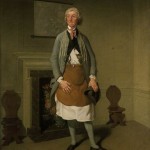Samuel de Wilde : Mr Suett as Dicky Gossip in ‘My Grandmother’ : 1797 : Ashmolean
Every now and again I come across a painting which I have never really stopped to look at before – however well I may think I know the gallery. The painting may not be large, or colourful, or dramatic – and it probably is not on the ‘hit list’ of must see paintings. Preparing for my hour long talks on single works, ‘Just One Painting’, at the Ashmolean Museum in Oxford I came across one such painting – the painting here illustrated. Tucked away in a rather tucked away gallery devoted to eighteenth century Fine and Applied Art, a delightful treasure-house, I suddenly noticed this rather insignificant work. I began to ask myself the same question I ask my, usually adult, students – What do you actually see? Here was a man, looking rather jovial, who appeared to be a tradesman or craftsman of some sort. The next query was why should anyone commission a painting of this workman? Perhaps a closer examination of the work might reveal useful information? On closer inspection the man appeared to have in his workman’s apron an odd collection of tools, including a saw and a pair of shears or large scissors – no obvious answer here! I then thought I had better squint at the label in hope of enlightenment – where I found that this was a painting of an actor, Dicky Suett, in a character role in a play ‘The Grandmother ‘ written by the nobly named ‘Prince Hoare’. The character he was playing was a certain ‘Dicky Gossip’. OK – I had gone some way but not far enough. So I went away and began to search for further enlightenment – which led me to a world far removed from the respectable and staid ethos of the Ashmolean Museum with it’s usually august painters and paintings, and it’s heroic subjects and famous and important people. This was the world of eighteenth and early nineteenth century theatre. In this context I knew about the ‘stars’ of the dramatic scene of that period – the actor/producer and impresario David Garrick, a portrait of whom hangs in another of the Ashmolean galleries, and such people as Sarah Siddons, famously portrayed by Thomas Gainsborough. I then remembered Hogarth’s painting of the controversial play ‘The Beggars Opera’, by John Gay. But this work, not by a famous painter but by someone I knew little about, ?Samuel ……. I dug further and found that the artist was better known for his respectable portraits of respectable people but that he had also been commissioned to paint a series of paintings of ‘character actors’ famous in the theatre-going world of the eighteenth century. The theatre in the eighteenth and early nineteenth century was a thriving, controversial, and often riotous part of social life at the time. London had many theatres and provincial centres aimed to have at least one theatre in their town or city. For most people characters like Dicky Suett were well known and sought after. Suett had been a chorister at Westminster Abbey, where he learnt his singing and acting skills – as did several of his fellow actors. ‘The Grandmother ‘ was a typical eighteenth century, rather ribald, sort of musical play – with ‘character’ parts and ‘character’ performers – Dicky Suett being one of the best. Trying to unearth the play is not that easy – but possible. The main character, who from time to time burst into song, was this Dicky Gossip – who had contrived to be a master of many skills, barber, carpenter, surgeon, apothecary, and so on. He claimed that all these skills were linked – barber could lead to dressing wounds – as apothecary he could provide medicine for ailments, keeping people alive – hopefully for a long, and to him, a profitable time – if and when he failed to keep them alive he could provide a coffin – and a relative, who was in the ‘family firm’, could dig the grave and be the Undertaker. In fact he could do everything! Somebody had commissioned this painting – which would have been popular at the time but in Victorian respectable circles would have been considered not ‘respectable’ and thus most such paintings have been lost.


2 Comments
Good to see your comments on Dicky Suett, an ancestor of mine. Like u say, not too easy to find info but I have looked long. He was star at Drury Lane, the Haymarket and Covent garden, George III’s favourite Shakespearean clown. Charles Lamb loved him and wrote about him in Essays of Elia. His son Theophilus was also on the stage. Dicky married Louise West who was a dancer in a Grimaldi’s troupe. His father John, was a guide to St Paul’s Cathedral and a butcher in Chelsea. They are buried next to each other under a big tree near the north wall of St. Paul’s churchyard. I have a notice for a play in which Dicky and his wife both played parts in Drury Lane. Dicky was also a composer and the British Library and Harvard have copies of his work. Etc.etc.
regards Pauline
Pauline – many thanks for your comments. I am delighted to make contact with a descendant of Dicky Suett – most unexpected. Fascinated about the details of other members of the family – and will visit St Paul’s Churchyard next time I pop up to London.
All the best,
David.